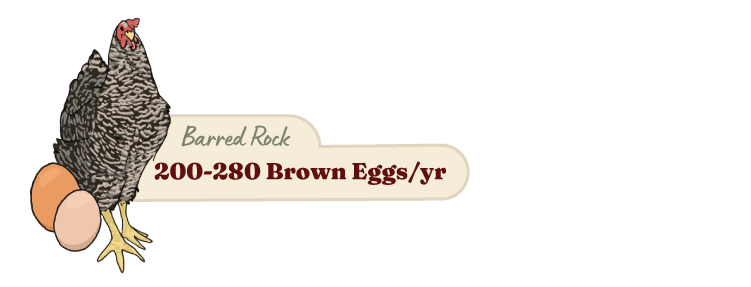Blog
Our 6 Favorite Chicken Breeds for Beginners
January 10, 2025
The Best Chicken Breeds for Beginners
Choosing the right chickens for your backyard flock can feel overwhelming—especially with so many great chicken breeds to choose from. Before you jump into the exciting world of backyard poultry, it’s important to do some research.
Many first-timers choose breeds based on their appearance or egg color, rather than finding chickens that will do best in their unique set up.
So, what types of chickens are right for you? When choosing chickens to add to your flock, it’s helpful to consider the following questions:
1. What are your local climate conditions? Some breeds are more tolerant than others to extreme cold and heat.
2. How much space do you have available? Certain breeds require a larger area to roam, while others do well in confined spaces. Consider the size of your property and your chicken coop.
3. What purpose do you want your poultry to serve? Are you raising chickens primarily for eggs, meat, or companionship? Maybe even a combination of the three?
Answering these questions will help narrow down the best chicken breeds for you.
For absolute beginners, we recommend starting with friendly, hardy breeds that adapt well to a variety of climates. These breeds are typically low-maintenance and will give your new flock the best chance to thrive—whether you’re raising them as pets or as a valuable resource for meat and eggs.
We’ll cover some of our all-time favorite breeds that will offer you a strong start in your journey of keeping backyard poultry.
Buff Orpingtons
This breed has stood the test of time—probably because the Buff Orpington checks a lot of boxes. They are friendly, cold hardy, and reliable egg layers. Buff Orpington chickens offer a level of versatility that makes them a strong choice for nearly any backyard setup, from the absolute beginner to the seasoned hobbyist.

History of Buff Orpingtons
Buff Orpingtons came about in late 19th century England. They were selectively bred to serve as a cold hardy, dual-purpose breed.
The first iteration of Orpingtons had black plumage, which helped mask the soot that was sometimes present on the streets of England.
To capitalize on the rising popularity of buff coloration, William Cook decided to cross a few chicken breeds (including Plymouth Rocks) to achieve the perfect shade of buff for his Orpingtons.
The first iteration of Orpingtons had black plumage, which helped mask the soot that was sometimes present on the streets of England.
To capitalize on the rising popularity of buff coloration, William Cook decided to cross a few chicken breeds (including Plymouth Rocks) to achieve the perfect shade of buff for his Orpingtons.
Appearance and Personality
Their plumage is often described as golden, fawn, or apricot in color. Even today, the buff color variety remains the most popular type of Orpington. Their feathers are so thick and dense, Orpingtons appear much larger than their actual body weight.
Buff Orpingtons are also one of the best kid-friendly breeds. They have earned a good reputation as backyard pets because of their calm, docile personalities. They are likely to bond with their owners and will actively seek your attention.
Buff Orpingtons are also one of the best kid-friendly breeds. They have earned a good reputation as backyard pets because of their calm, docile personalities. They are likely to bond with their owners and will actively seek your attention.
Purpose
This is a classic dual-purpose breed, but they are also incredibly popular as pets.
Whether you wish to keep them as friendly backyard pet or plan to use them for production within your flock, you can’t go wrong with a Buff Orpington.
Whether you wish to keep them as friendly backyard pet or plan to use them for production within your flock, you can’t go wrong with a Buff Orpington.
Other Things to Consider
This breed does not fare as well in climates that are consistently hot and humid year-round. This breed is best suited to cold climates, or climates where there are cold winters and hot summers.
Buff Orpingtons are great mothers, so they are more likely to go broody than other types of chickens. Keep this in mind if you’d rather not add a broody hen to your flock.
Buff Orpingtons are great mothers, so they are more likely to go broody than other types of chickens. Keep this in mind if you’d rather not add a broody hen to your flock.
Silkie Chickens
White Silkies fall under the category of Bantams, which is a smaller variety of “mini” chicken. While full-size versions of this breed do exist (typically in Europe), the variety available in the United States are considered a Bantam breed. If you have a small chicken coop or limited backyard space, Silkie chickens are the ideal pet for you.

History of Silkie Chickens
While their exact origins are unclear, Silkies are generally traced back to 13th century China. They are considered one of the oldest purebred chicken breeds around today.
Appearance and Personality
This Bantam variety has beautiful plumage that gives them a fluffy appearance. They are also soft to the touch. Silkie chickens come in other color varieties as well, including buff, black, and blue.
Silkies are the only chickens that have black to bluish black skin, bones, and beaks—they even have black chicken meat. Because it is so rare, their black chicken meat is considered a delicacy in some countries or niche markets.
Silkies have five toes as opposed to the typical four you’ll find on other chickens—they even have blue earlobes. The unusual appearance of White Silkie chickens only adds to their appeal for chicken lovers and backyard poultry enthusiasts.
This breed is known to be docile, friendly and calm. They make for a great backyard pet, especially if you have small children.
Silkies are the only chickens that have black to bluish black skin, bones, and beaks—they even have black chicken meat. Because it is so rare, their black chicken meat is considered a delicacy in some countries or niche markets.
Silkies have five toes as opposed to the typical four you’ll find on other chickens—they even have blue earlobes. The unusual appearance of White Silkie chickens only adds to their appeal for chicken lovers and backyard poultry enthusiasts.
This breed is known to be docile, friendly and calm. They make for a great backyard pet, especially if you have small children.
Purpose
Silkies are primarily suited as backyard pets or for ornamental purposes, but could be used in niche markets for meat production.
If you’d like to raise more birds on your farm or homestead, they are also great at incubating and raising the offspring of other chickens.
If you’d like to raise more birds on your farm or homestead, they are also great at incubating and raising the offspring of other chickens.
Other Things to Consider
Silkies (and Bantams as a whole) are notoriously broody, so keep that in mind if you’d rather not add a broody hen to your flock.
Silkies are not considered to be prolific layers. Since Bantam breeds are much smaller than standard size chickens, the eggs they lay are quite small as well.
If you’re looking to raise a true dual-purpose breed, then this is not the ideal bird for you. Standard size chickens would be your best bet.
Silkies are not considered to be prolific layers. Since Bantam breeds are much smaller than standard size chickens, the eggs they lay are quite small as well.
If you’re looking to raise a true dual-purpose breed, then this is not the ideal bird for you. Standard size chickens would be your best bet.
Rhode Island Reds
The Rhode Island Red is a cross between multiple breeds—the aim was to create a high yield dual-purpose bird. This breed is a longtime farm and backyard favorite due to their practicality and friendly demeanor—within the chicken world, this breed is considered culturally significant, with an almost iconic status. They are a great option for free-range.

History of the Rhode Island Red
This breed was developed in both Rhode Island and Massachusetts, starting in the latter half of the 19th century. They quickly gained popularity due to their hardiness, adaptability, and reliable egg production.
In 1954, the Rhode Island Red was officially named as the state bird of Rhode Island. Interestingly, they are the only chicken breed with this honor.
In 1954, the Rhode Island Red was officially named as the state bird of Rhode Island. Interestingly, they are the only chicken breed with this honor.
Appearance and Personality
This bird has deep red to reddish brown feathers, almost mahogany in color. Their tail is usually partially or fully black. They have yellow beaks and legs with a bright red comb.
They are quite robust in size once they reach maturity, so they are suitable as a dual-purpose bird.
This chicken is calm and usually willing to be handled. They have a tendency to be a bit dominant, so they will likely be at the top of the pecking order in most flocks.
They are quite robust in size once they reach maturity, so they are suitable as a dual-purpose bird.
This chicken is calm and usually willing to be handled. They have a tendency to be a bit dominant, so they will likely be at the top of the pecking order in most flocks.
Purpose
The Rhode Island Red chicken was developed to be a true dual-purpose breed. They are still considered one of the top producers of large brown eggs.
They are friendly and could be suitable as pets, but roosters may become aggressive during mating season.
They are friendly and could be suitable as pets, but roosters may become aggressive during mating season.
Other Things to Consider
Rhode Island Reds reach maturity more quickly than other dual-purpose breeds, making them a productive addition to any flock.
Barred Rocks
Another longtime favorite, Barred Rocks are a dual-purpose bird and a great addition to any farm or backyard flock. They are the most well-known variety of the Plymouth Rock chicken, and their striped/barred feather pattern is considered to be quite beautiful. They are a great option for free-range.

History of Barred Rocks
This breed first appeared in 19th century New England, making its debut at a poultry show in Boston. It took a few decades before this breed caught on with farmers and hobbyists, but the breed quickly gained popularity once growers recognized the breed’s utility.
They are a variety of the Plymouth Rock breed, which also has 8 other variations.
They are a variety of the Plymouth Rock breed, which also has 8 other variations.
Appearance and Personality
A key feature of the breed is their distinct black and white barring pattern, making them easy to spot amongst the flock. They also have bright yellow legs and beaks that stand out against their feathers.
They bear a resemblance to Cuckoo Marans, but you can typically tell them apart by observing the color of their feet (Barred Rocks have yellow feet, while Cuckoo Marans have gray or slate colored feet). Cuckoo Marans also tend to have a less distinct barring pattern than Barred Rocks.
This breed is very calm and friendly, and they typically do not mind being handled by their owners.
In addition to getting on well with humans, this breed gets along well with other birds. They are a great choice for mixed flocks (flocks with multiple species). If you already have ducks, geese, turkeys, or other poultry on your property, Barred Rocks are a great addition.
They bear a resemblance to Cuckoo Marans, but you can typically tell them apart by observing the color of their feet (Barred Rocks have yellow feet, while Cuckoo Marans have gray or slate colored feet). Cuckoo Marans also tend to have a less distinct barring pattern than Barred Rocks.
This breed is very calm and friendly, and they typically do not mind being handled by their owners.
In addition to getting on well with humans, this breed gets along well with other birds. They are a great choice for mixed flocks (flocks with multiple species). If you already have ducks, geese, turkeys, or other poultry on your property, Barred Rocks are a great addition.
Purpose
This is a classic dual-purpose bird, but their laid-back personality with humans and other birds makes them great as pets too.
Other Things to Consider
Roosters of this breed can be above average when it comes to noise level. Because they are deferential with other birds, they can also sit lower on the pecking order.
Black Australorps
Hailing all the way from Australia, this dual-purpose breed has earned its place in the hearts of American homesteaders and farmers. Bred to be high performing egg layers, Black Australorps have outpaced other layers in a similar category, which has solidified them as a mainstay among egg laying chicken breeds.

History of Black Australorps
To achieve their egg production and body size, many high performing breeds were used to create Australorps. Among other breeds, growers used Leghorns, as well as Black Orpington stock from England—the very same that were developed by William Cook.
Appearance and Personality
While other varieties are recognized in Australia, the version that is recognized in America have shiny black feathers. In the sunlight, these feathers give off an iridescent green/teal sheen. This large black chicken has a beautiful bright red comb that offers a stark contrast against their shiny plumage.
As a heavy bodied bird, they are quite large and robust once they reach maturity.
As a heavy bodied bird, they are quite large and robust once they reach maturity.
Purpose
Black Australorps are prized for their egg laying capabilities. These birds are excellent layers and make a productive addition to any flock. Because of their large size, they are suitable as a dual-purpose bird.
Australorps are quiet and peaceful, so they’d be great as backyard pets. They are known for being highly intelligent and curious, with the ability to learn basic tricks.
Australorps are quiet and peaceful, so they’d be great as backyard pets. They are known for being highly intelligent and curious, with the ability to learn basic tricks.
Other Things to Consider
Like the Buff Orpington, these birds tend to fare better in cold climates rather than climates that are hot and humid year-round.
Olive Eggers
The Olive Egger chicken is a hybrid variety, so their appearance can vary greatly from bird to bird. They aren’t considered an official breed by the American Poultry Association (APA) because they don’t conform to a breed standard. Like the name suggests, these birds are known for their beautiful olive green eggs.

History of the Olive Egger
Olive Eggers were developed in the early 20th century by crossing blue/green egg layers, like Ameraucanas or Araucanas, with brown egg layers, such as Marans. This crossbreeding allows the Olive Egger to achieve the beautiful shades of green their eggs are known for.
Olive Eggers lay a very distinct shade of olive green, whereas Ameraucanas may lay eggs that are more of a pastel green or blue.
Olive Eggers lay a very distinct shade of olive green, whereas Ameraucanas may lay eggs that are more of a pastel green or blue.
Appearance and Personality
Because they are hybrids, their feather pattern and color can vary greatly. Olive Eggers may be gray, white and black, or light to dark brown. They may even have a “muff” or a beard that gives them a unique and charming look. They share some of their appearance with the Ameraucana.
These birds are usually friendly and curious, making them a fun addition to any backyard.
These birds are usually friendly and curious, making them a fun addition to any backyard.
Purpose
They are valued for their beautiful eggs and a popular choice as a backyard pet. While not as large as some of the other layers we discussed, this could be a dual-purpose bird.
Other Things to Consider
They are known for laying olive green eggs, but because they are a cross, your Olive Egger could lay a different egg color (on rare occasions, brown, tan, blue, or pink).
Whatever egg color your Olive Egger starts laying, that is the color they will lay for their lifetime.
Whatever egg color your Olive Egger starts laying, that is the color they will lay for their lifetime.
Start Your 2025 Flock Strong with Myers Poultry
There is no single breed that will be perfect for every farm. The best thing you can do is find the breed or breeds that will suit your unique situation.
If maximum egg production is your aim, then we recommend the Red Sex Link. They are the top producer of extra-large brown eggs. White Leghorns are also a good choice for maximum egg production of extra-large white eggs, but this breed can be a bit more challenging for beginners.
Both of these breeds lay eggs that are most commonly found in grocery stores, so they are considered by far the best laying breeds among their peers.
If you need help deciding on which breeds to add to your flock, you can always call us directly to receive expert advice on your poultry.
If maximum egg production is your aim, then we recommend the Red Sex Link. They are the top producer of extra-large brown eggs. White Leghorns are also a good choice for maximum egg production of extra-large white eggs, but this breed can be a bit more challenging for beginners.
Both of these breeds lay eggs that are most commonly found in grocery stores, so they are considered by far the best laying breeds among their peers.
If you need help deciding on which breeds to add to your flock, you can always call us directly to receive expert advice on your poultry.
How Many Chickens Should I Start With?
It can sometimes be a challenge to find a hatchery that will ship smaller orders of birds. At Myers Poultry, we have minimum order requirements for certain breeds to ensure a safe shipment, but if you are local to the area, we offer no minimums on pickup orders. So, if you’re finally ready to start your small flock, consider starting it with us.
Myers Poultry offers a wide variety of chicken breeds, from layers, bantams, meat birds, and more, to give you a well-rounded flock that meets your needs. Browse our selection of chickens for sale to find the breeds that fit your farm.
If you’d like to place a pick-up order, please call the office to arrange a pick-up time rather than ordering online. We only offer pick-up on certain days of the week to ensure the safety of our birds.
Follow us on social media to stay up to date with our latest offerings!